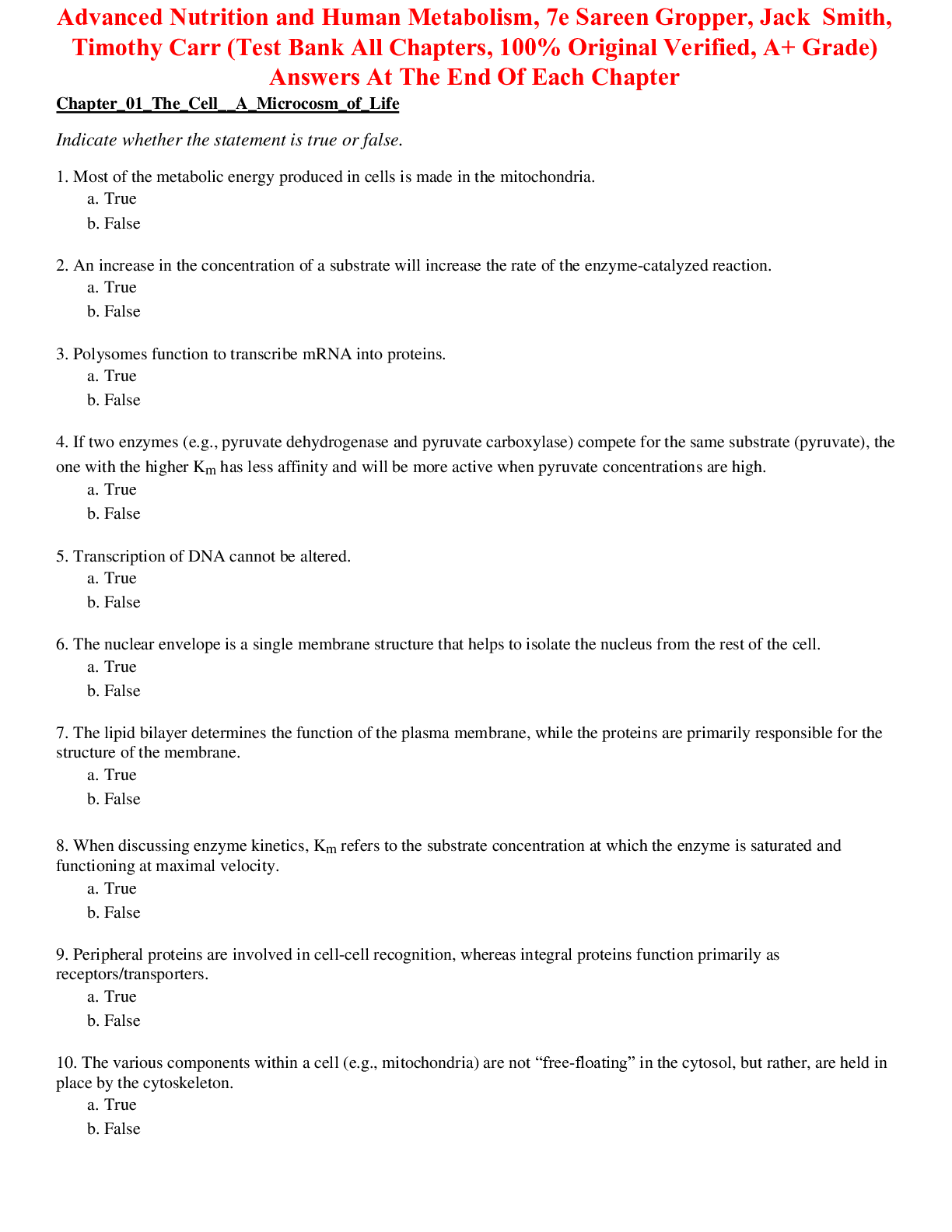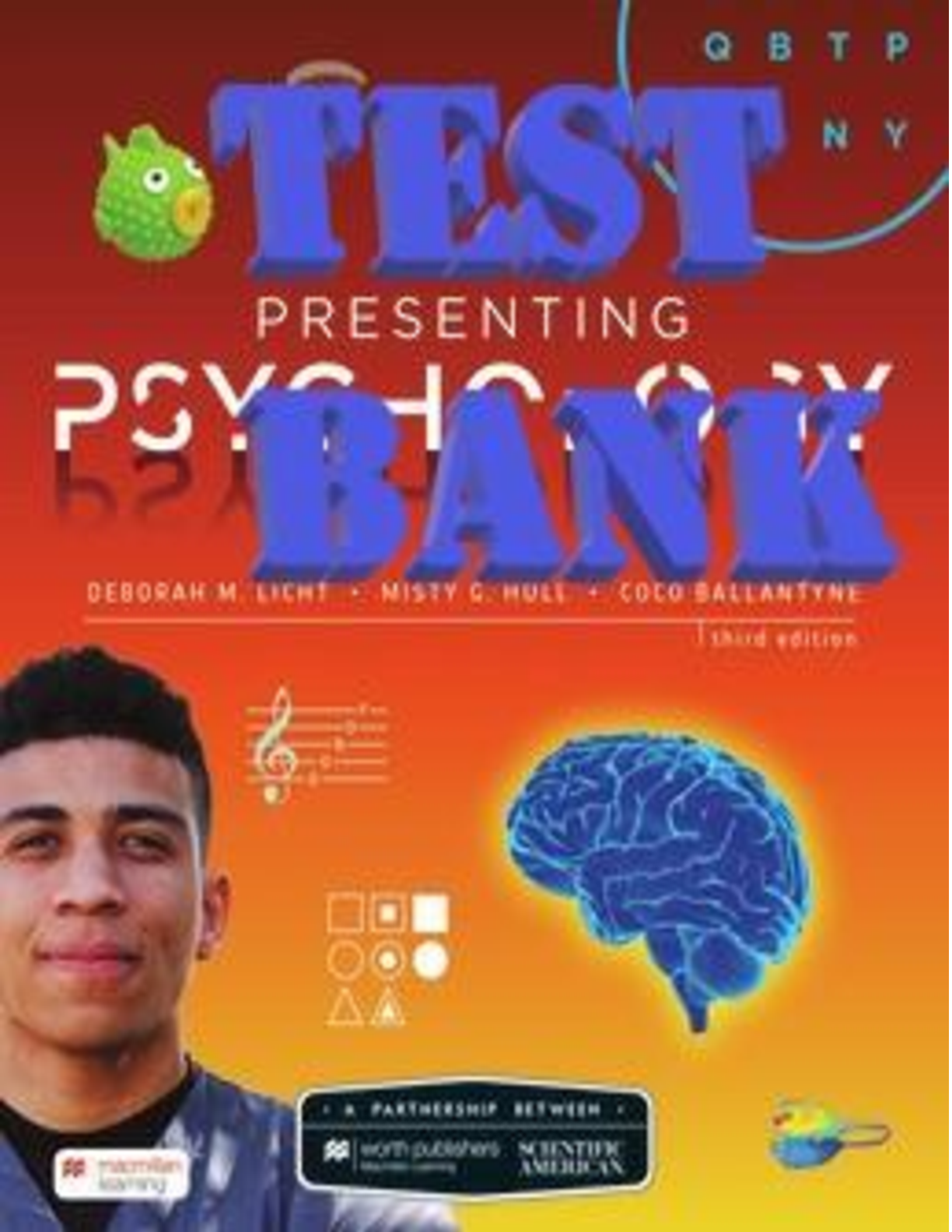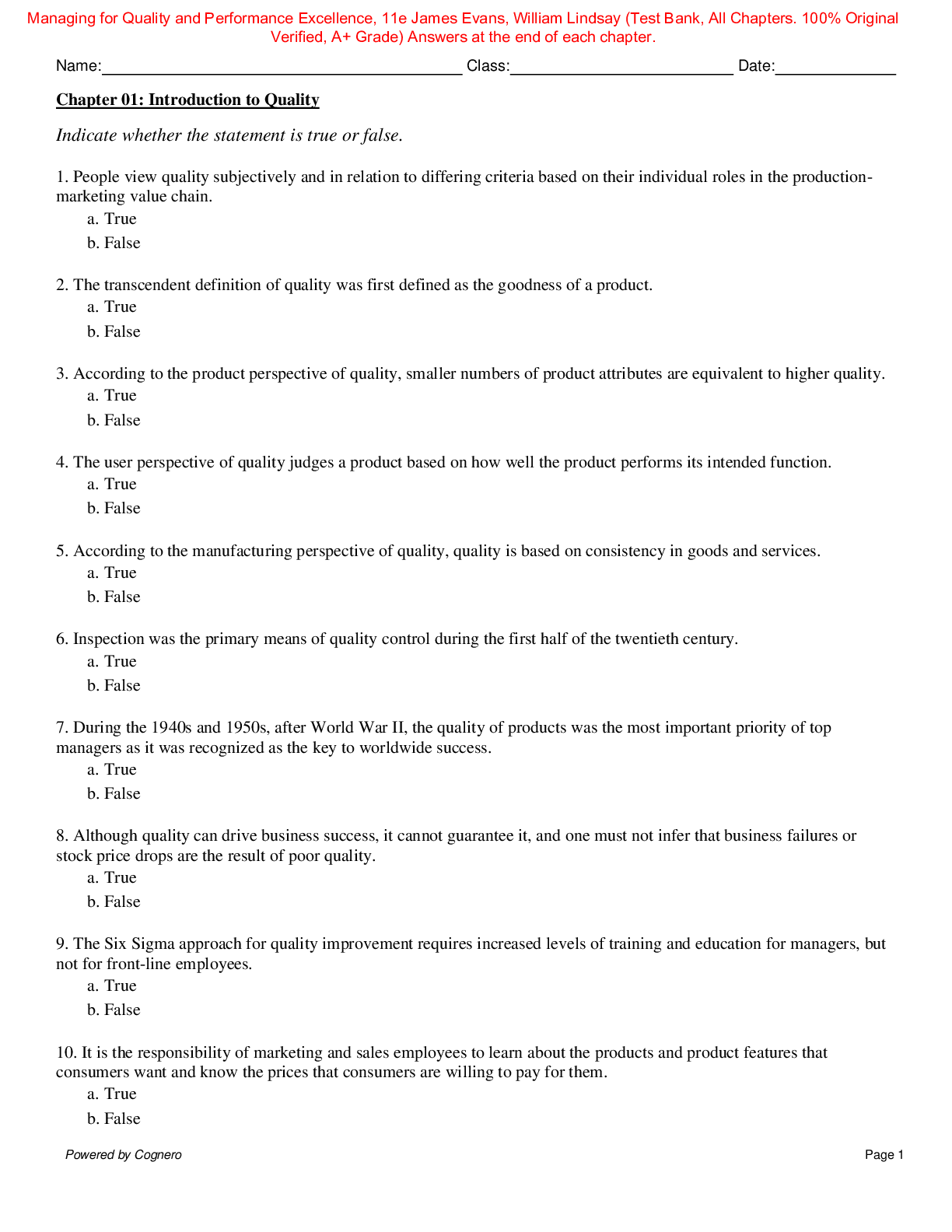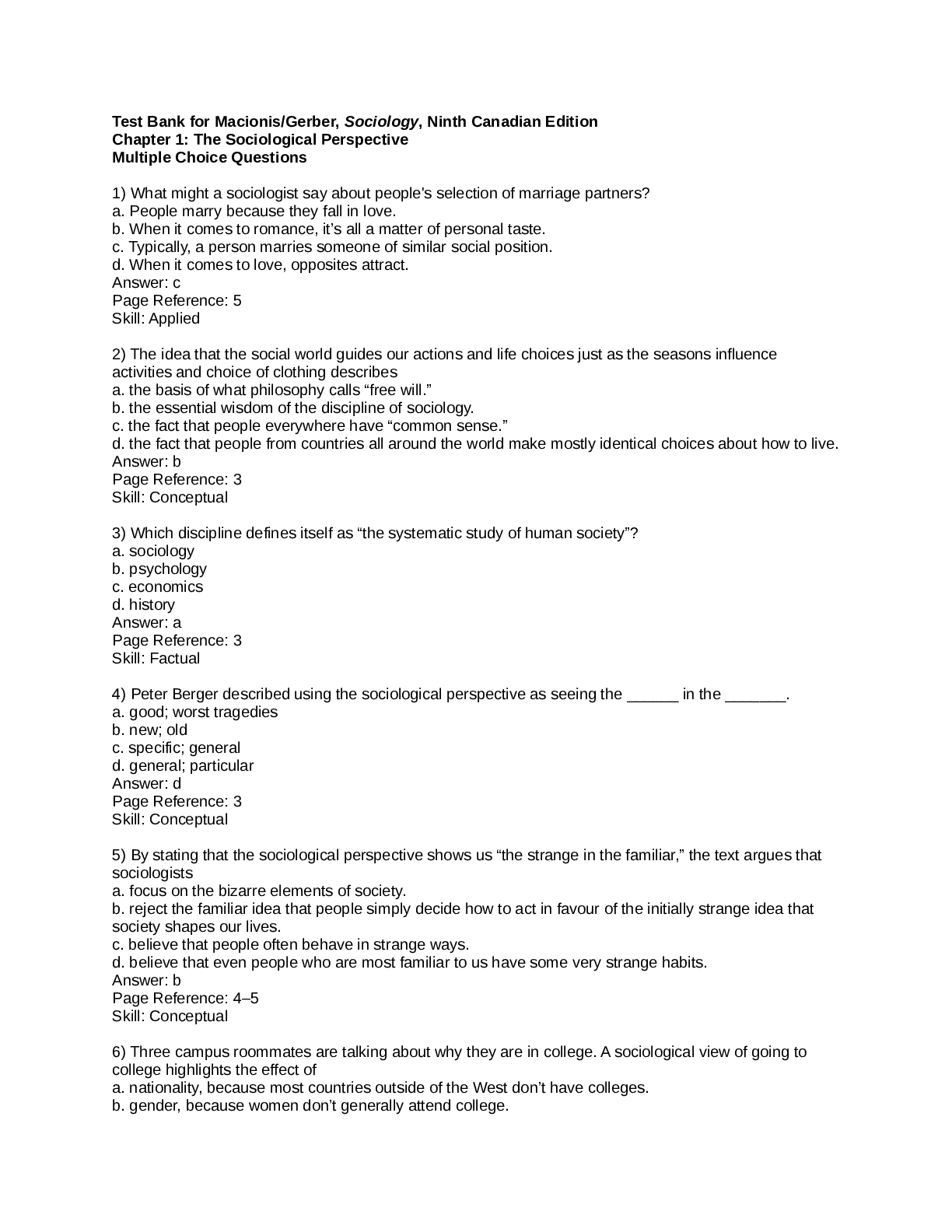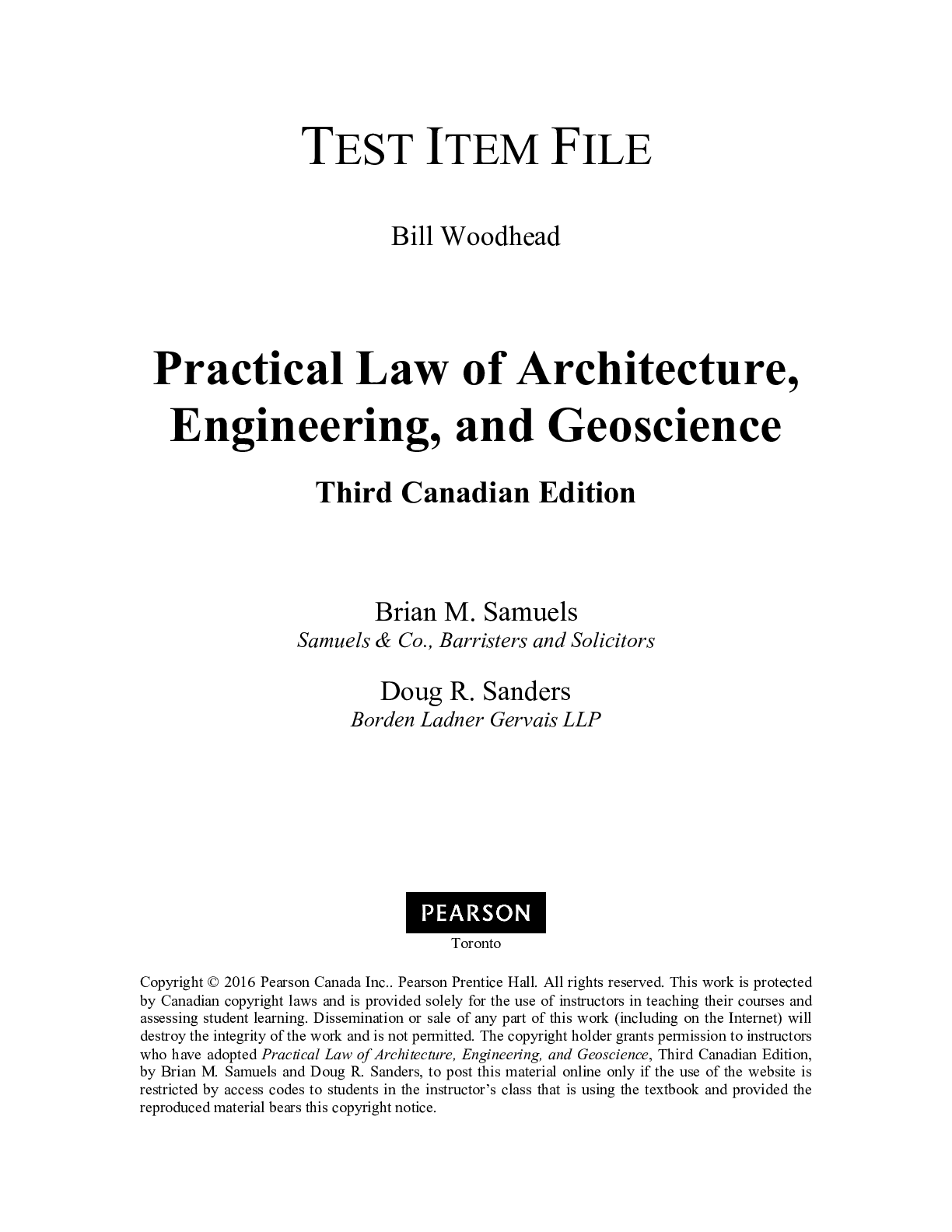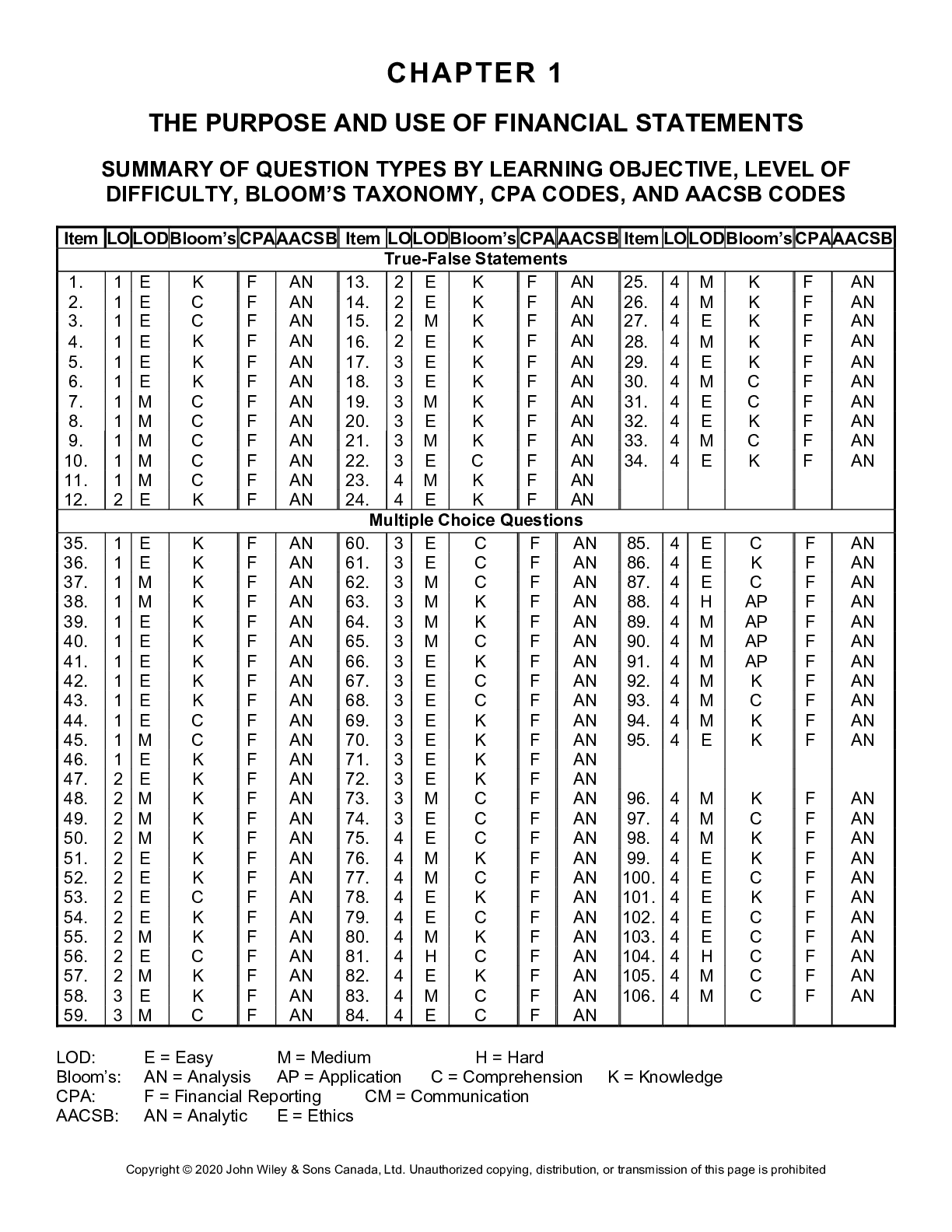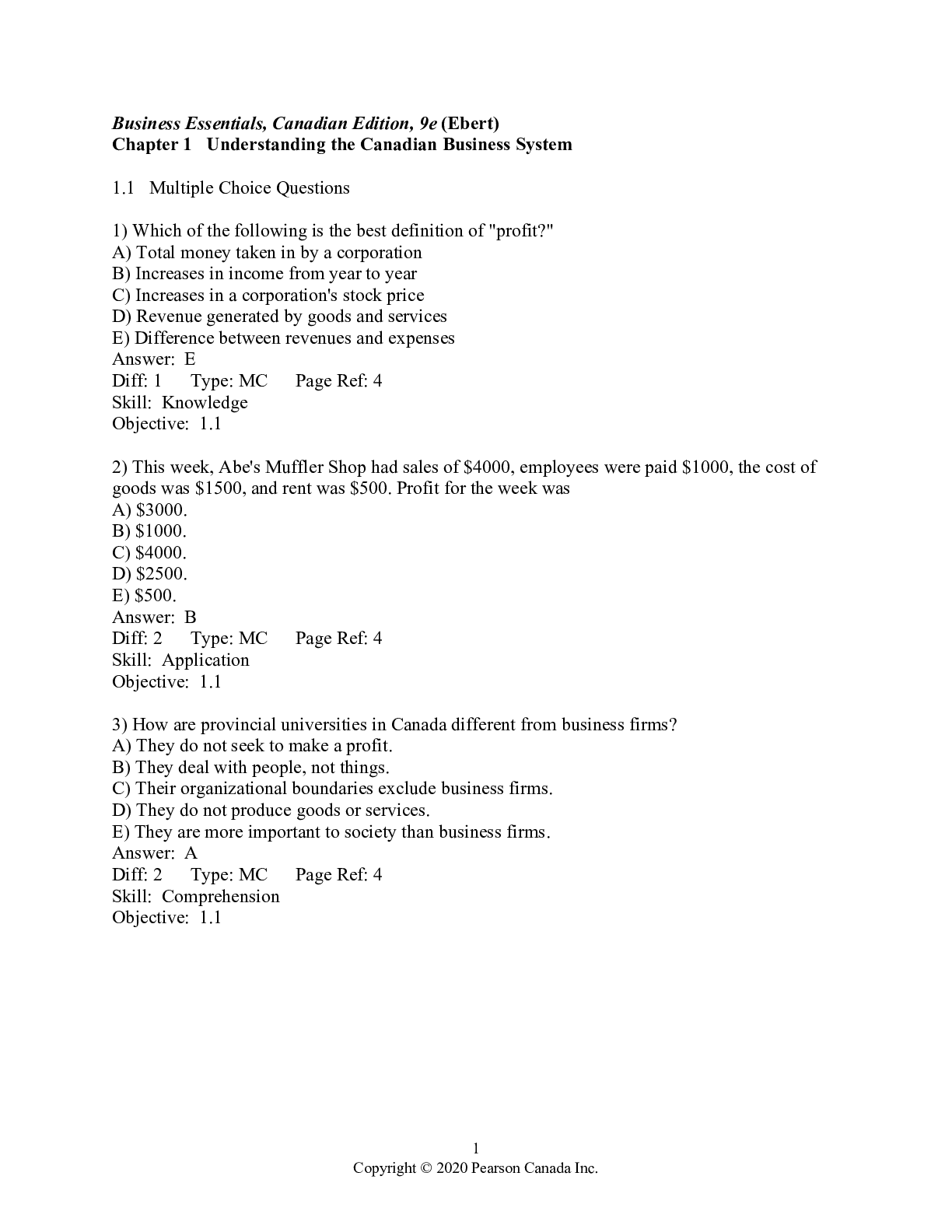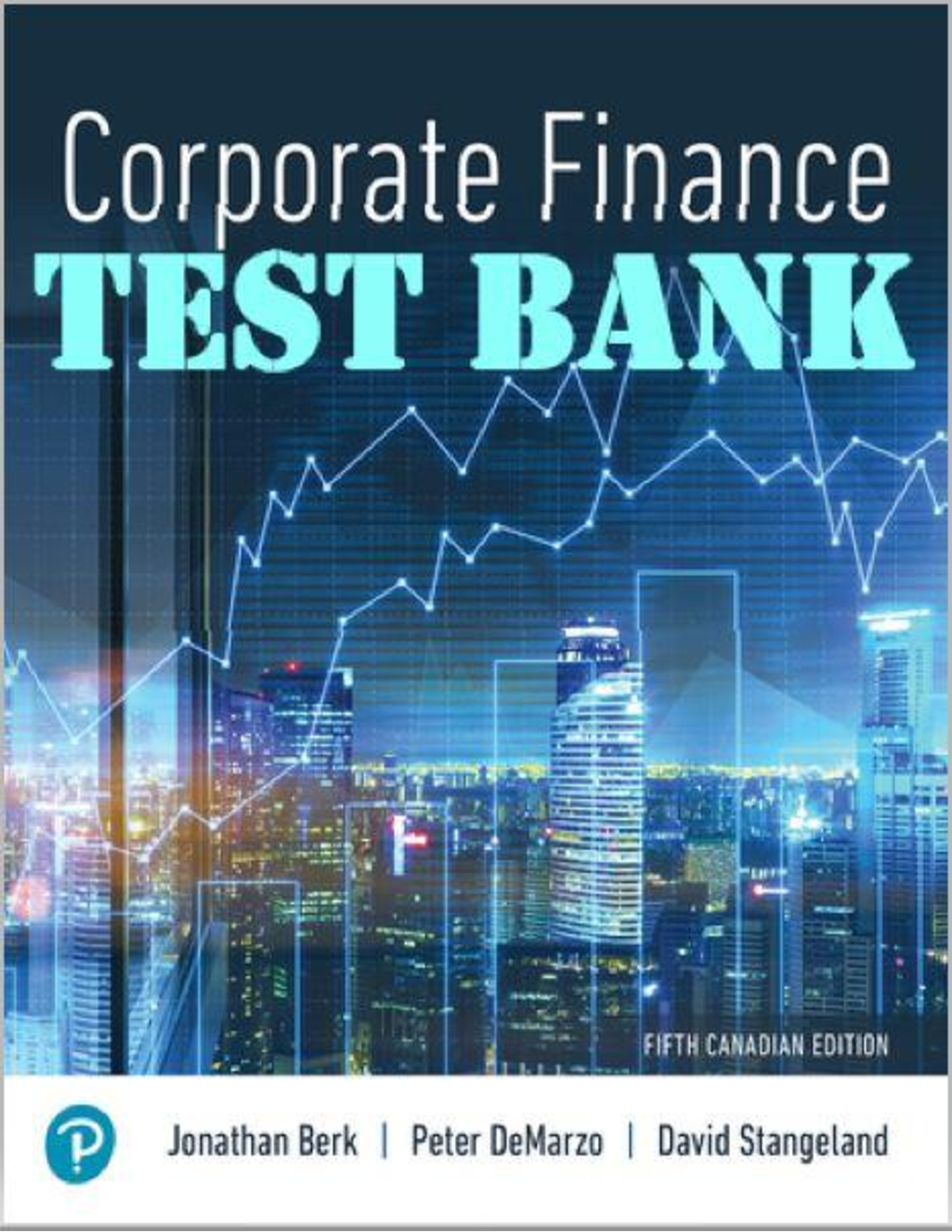Business > TEST BANK > Business Law in Canada, 12th Canadian Edition, 12e Richard Yates, Teresa Bereznicki-Korol, Trevor (All)
Business Law in Canada, 12th Canadian Edition, 12e Richard Yates, Teresa Bereznicki-Korol, Trevor Clarke (Test Bank)
Document Content and Description Below
About This Course Changes to the 12th Edition Content Highlights A Note on Indigenous Terminology Acknowledgments and Dedications Part 1 Introduction Chapter 1 Managing Your Legal Affairs Learn... ing Objectives “I Think I Need Legal Advice . . . ” Becoming A Sophisticated Client The Role of the Lawyer Should I Hire a Lawyer? When to Hire a Lawyer When to Represent Yourself How to Find an Appropriate Lawyer How Lawyers Bill Their Clients Legal Aid How to Complain about Your Lawyer Ethics Ethics of Lawyers Ethics of Clients Code of Business Conduct Social Responsibility Summary Becoming a sophisticated client The role of the lawyer Should I hire a lawyer? How to find an appropriate lawyer How lawyers bill their clients Legal aid How to complain about your lawyer Ethics Questions for Review Chapter 2 Introduction to the Legal System Learning Objectives What Is Law? Categories of Law Canada’s Legal Systems Civil Law Legal System Common Law Legal System Stare Decisis Common Law and the Law of Equity Equity Statutes The Constitution of Canada Confederation Constitution and Division of Powers Indigenous Rights and Self-Government Indigenous Self-government in Canada Constitutional Challenges before the Courts Paramountcy Delegation of Powers Agreements to Share Powers Exercising Legislative Power Protection of Rights and Freedoms Canadian Bill of Rights35 Charter of Rights and Freedoms Limitations Charter Provisions Fundamental Freedoms Democratic Rights Mobility Rights Legal Rights Equality Rights Language Rights Section 52 The Importance of the Changes to the Constitution Human Rights Legislation Indigenous Peoples and Human Rights Summary A workable definition of “law” Categories of law Canada’s legal systems Constitution of Canada Charter of Rights and Freedoms Human rights legislation Questions for Review Chapter 3 The Resolution of Disputes: The Courts and Alternatives to Litigation Learning Objectives Alternatives to Court Action What Is Alternative Dispute Resolution? Advantages of ADR Versus Litigation Disadvantages of ADR Versus Litigation ADR Mechanisms Negotiation Mediation Disadvantages of Mediation Arbitration The Courts Trial Courts of the Provinces Recent Developments Provincial Courts of Appeal Courts at the Federal Level The Process of Civil Litigation Limitation Periods Jurisdiction Pre-trial Procedures Recent Initiatives The Trial Judgment Costs Remedies Enforcement Enforcing Judgment Seizure of Property Judicial Remedies before Judgment Class Actions The Nature and Function of Regulatory Bodies Procedural Fairness in Tribunals 1. The Authority of the Decision Maker 2. The Fairness of the Process 3. Reviewing a Decision Methods of Judicial Review Summary Alternative dispute resolution (ADR) The courts Process of civil litigation Dealing with regulatory bodies Questions for Review Part 2 Torts Chapter 4 Intentional Torts and Torts Impacting Business Learning Objectives The Nature of Torts Intentional Torts Trespass to Person: Assault and Battery Defences Trespass to Land Trespass to Chattels, Conversion, and Detinue False Imprisonment Malicious Prosecution Private Nuisance Defamation Defences Injurious Falsehood (Product Defamation) Successfully Establishing a Tort Claim Other Torts Impacting Business Inducing Breach of Contract Unlawful Means Tort Intimidation Deceit (Fraudulent Misrepresentation) Conspiracy Passing-Off Misuse of Confidential Information Privacy Evolution of Tort Law Online Torts Summary Intentional torts Other business torts Online torts Questions for Review Chapter 5 Negligence, Professional Liability, and Insurance Learning Objectives Negligence The A, B, C, and D of Negligence A: A Duty to Exercise Care Must Exist Misfeasance and Nonfeasance B: Breach of the Standard of Care C and D: Causation and Damages “But For” Test: Physical Causation Remoteness Test—Legal Causation Defences Voluntary Assumption of Risk Contributory Negligence Illegality (Ex Turpi Causa) Legislation Impacting Duty of Care Occupiers’ Liability Innkeepers’ Liability Strict Liability Vicarious Liability Product Liability Liability of Professionals and Other Experts Contract Negligence To Whom Is a Duty Owed? A. Negligent Misstatement B. Breach of Standard of Care C. Causation and Reliance Fiduciary Duty and Breach of Trust Professional Insurance Insurance The Insurance Industry Types of Insurance A. Liability Insurance B. Property Insurance C. Business Interruption Insurance D. Life and Health Insurance E. Bonding Insurable Interest Limitation Clauses (Exclusion Clauses) Contract of Utmost Good Faith Subrogation Summary Negligence Professional liability Insurance Questions for Review Part 3 Contracts Chapter 6 The Elements of a Contract: Consensus and Consideration Learning Objectives The Contractual Relationship Definition of a Contract Elements of a Contract Important Terms and Definitions Formal and Simple Contracts Express and Implied Contracts Valid, Void, and Voidable Contracts Unenforceable and Illegal Contracts Bilateral and Unilateral Contracts Consensus A Meeting of the Minds Offer Invitation to Treat Offer by Conduct Communication of an Offer The End of an Offer Offers That Cannot Be Revoked Standard Form Contract Duty of Good Faith Acceptance Communication of Acceptance The Postbox Rule Electronic Transactions Consensus E-commerce Legislation Consideration The Price You Are Willing to Pay Adequacy of Consideration Gratuitous Promises Are Not Consideration Existing Duty Past Consideration Paying Less to Satisfy a Debt Illegal Consideration Examples of Valid Consideration Settlement Out of Court Request for Services Exceptions to the General Rule Promissory Estoppel Sealed Documents Summary The contractual relationship Consensus Consideration Questions for Review Chapter 7 The Elements of a Contract: Capacity, Legality, and Intention Learning Objectives Capacity Minors/Infants Necessaries and Beneficial Contracts of Service On Becoming an Adult Parents’ Liability Infants’ Liability for Torts Insanity and Drunkenness Others of Limited Capacity Legality Contracts Performed Illegally Contracts Formed Illegally Examples Intention Form of the Contract The Requirement of Writing When Writing is Required What Constitutes Evidence in Writing Effect of The Statute of Frauds Electronic Contracts Part Performance Summary Capacity Legality Intention Form of the contract Questions for Review Chapter 8 Factors Affecting the Contractual Relationship Learning Objectives Misrepresentation Allegation of Fact Silence or Non-Disclosure False Statement Statement Must Be Inducement Misrepresentations That Are Also Terms of the Contract Innocent Misrepresentation Negligent Misrepresentation Fraudulent Misrepresentation Duress, Undue Influence, and Unconscionable Transactions Duress Undue Influence Unconscionable Transactions Mistake Shared Mistake Rectification Misunderstanding One-Sided Mistake Non Est Factum Rules of Interpretation Privity Of Contract and Assignment Privity Exceptions Assignment Negotiable Instruments Summary Misrepresentation Duress, undue influence, or unconscionability Mistake Privity of contract Assignment Negotiable instruments Questions for Review Chapter 9 The End of the Contractual Relationship Learning Objectives Discharge by Performance Tender Discharge by Breach Breach by Improper or Incomplete Performance Conditions and Warranties Exemption Clauses Fundamental Breach Breach by Refusal to Perform (Repudiation) Discharge by Agreement Contractual Terms Discharge by Frustration Circumstances Not Constituting Frustration Effect of Frustration Remedies for Breach of Contract Damages Limitations on Recoverable Damages Remoteness Mitigation Contractual Limitations Equitable Remedies Rescission Rectification Specific Performance Injunction Accounting Quantum Meruit Summary Discharge of contracts Discharge by performance Discharge by breach Discharge by agreement Discharge by frustration Remedies Questions for Review Part 4 Methods of Carrying on Business Chapter 10 Agency and Partnership Learning Objectives The Agency Relationship Creation of the Agency Relationship Formation by Contract Formation by Estoppel Formation by Ratification Formation by Necessity The Duties of the Parties in an Agency Relationship The Agent’s Duties Fiduciary Duty Fiduciary Duty Owed to Indigenous Peoples The Principal’s Duties The Liabilities of the Parties in an Agency Relationship The Agent’s Liabilities The Principal’s Liabilities Undisclosed Principals Termination of an Agency Relationship Enduring Powers of Attorney Types of Business Organization Sole Proprietorship Partnership Creation of a Partnership Creation by Inadvertence Creation by Contract Creation by Estoppel Registration Rights and Duties of Partners Provisions of the Partnerships Act Fiduciary Duty Liabilities of Partners Liability through Agency Vicarious Liability Unlimited Liability Dissolution of a Partnership Distribution of Assets and Liabilities Advantages of Partnership Other Types of Business Organizations Limited Partnerships Limited Liability Partnerships Joint Ventures Summary Agency relationship How to create an agency relationship The duties of the parties The liabilities of the parties Termination of the agency relationship Sole proprietorship Partnership Creation of a Partnership Rights and duties of partners Liabilities of partners Dissolution of a partnership Advantages of partnership Other types of business organizations Questions for Review Chapter 11 Corporations Learning Objectives Separate Legal Entity The Role of Agents Pros and Cons of Incorporation Advantages Limited Liability Taxes Succession and Transferability Obligations of the Participants Management Disadvantages The Process of Incorporation Registration Letters Patent Articles of Incorporation Other Incorporated Bodies Capacity Funding Par-Value versus No-Par-Value Shares Special Rights and Restrictions Borrowing Closely Held and Broadly Held Corporations Corporate Directors, Officers, and Shareholders Directors (Managers) Within the Corporation External Obligations Officers and Senior Executives Promoters Shareholders Rights Shareholder Protections Dividends Shareholder Agreements Termination of the Corporation Summary Separate legal entity Pros and cons of incorporation The process of incorporation Funding Corporate directors, officers, and shareholders Termination of the corporation Questions for Review Chapter 12 Employment Learning Objectives What Is Employment? The Control Test The Organization Test, Risk Test, and Tools Test The Law of Employment The Employment Contract Termination Reasonable Notice Just Cause Dishonesty and Misconduct Disobedience and Insubordination Incompetence Illness and Disability Layoffs Constructive Dismissal Remedies for Wrongful Dismissal Wrongful Leaving Liability of Employer Legislation Impacting Employment Employment Standards Termination Issue Estoppel Complaints Human Rights Health and Safety Workers’ Compensation Employment Insurance Other Legislation Collective Bargaining Legislation Organization of Employees Certification Bargaining Agent Unfair Labour Practices Bargaining Ratification Mediation and Arbitration Terms of Collective Agreements Grievance Process Arbitration Strikes and Lockouts Picketing Public Sector and Essential Services Union Organization Summary What is employment? The law of employment Collective bargaining Questions for Review Part 5 Property and Information Technology Chapter 13 Intellectual Property Learning Objectives Intellectual Property Copyright Matters Covered File Sharing Creation Ownership 2012 Amendments to the Copyright Act Fair Dealing Copyright Infringement Other Exceptions Remedies The Copyright Board Patents Creation Trademarks Passing-off Industrial Designs and Integrated Circuit Topography Confidential Information Trade Secrets Remedies Regulating Information Technology Protecting Private Information Additional Challenges Dispute Resolution Regulatory Trends Criminal Activity and Other Abuses Summary Intellectual property Copyright Patents Trademarks Industrial designs Confidential information Questions for Review Chapter 14 Real and Personal Property and Protection of the Environment Learning Objectives Real versus Personal Property Real Property Interests in Land Estates in Land Fee Simple Life Estate Leasehold Estates Lesser Interests in Land Tenancy in Common and Joint Tenancy Other Interests in Land Transfer and Registration of an Interest in Land Condominiums and Cooperatives Mortgages Equity of Redemption Foreclosure Right to Sell The Landlord–Tenant Relationship Leasehold Estates Types of Tenancies Rights and Obligations of the Parties Vacant Possession Quiet Enjoyment Repair of Premises Termination Tenants’ Obligations Remedies Residential Tenancies Personal Property Chattels Finders Keepers Bailment Bailment for Value Exemption Clauses Common Carriers Innkeepers’ Liability Gratuitous Bailment Involuntary Bailment Additional Rights and Obligations Protection of the Environment Common Law The Federal Government Provincial Legislation Other Important Issues in Environmental Projects Summary Real property Mortgages Leasehold estates Personal property Environment protection Questions for Review Part 6 Commercial Transactions Chapter 15 Priority of Creditors Learning Objectives Methods of Securing Debt Personal Property The Traditional Approach The Personal Property Security Act Creating a Secured Relationship Priority of Secured Creditors Rights and Remedies upon Default Guarantees Rights and Obligations of the Parties Other Forms of Security The Bank Act Floating Charges Builders’ Liens Negotiable Instruments Letters of Credit Related Laws Landlord’s Right to Distrain for Rent Fraudulent Transfers and Preferences Bankruptcy Introduction The Process Summary Methods of securing debt—personal property Personal Property Security Act Guarantees Other forms of security Related laws Bankruptcy—introduction The process of bankruptcy Priority among creditors in bankruptcy Bankruptcy offences After discharge from bankruptcy Alternatives to bankruptcy Questions for Review Chapter 16 Sales and Consumer Protection Learning Objectives The Sale of Goods Purpose and Application of the Sale of Goods Act Goods and Services Transfer of Goods for Monetary Consideration Title and Risk Transfer of Title Rule 1 Rule 2 Rule 3 Rule 4 Rule 5 Rights and Obligations of the Parties Right to Convey Clear Title Goods Must Match Description Goods Must Be of Merchantable Quality and Fit for Purpose Goods Must Match Sample Other Implied Terms Remedies on Default Seller’s Remedies Buyer’s Remedies Online Sales and International Transactions Online Purchases International Transactions Consumer Protection Federal Legislation Competition Other Federal Legislation Identity Theft Provincial Legislation Responsibility for Goods Unacceptable Business Practices False or Exaggerated Claims Unconscionable Transactions Prepaid Cards Controlled Business Practices Methods of Control Loan Transactions Debt Collection Processes Consumer Service Bodies Negotiable Instruments Electronic Money Summary Sale of Goods Act Consumer protection Negotiable instruments Questions for Review [Show More]
Last updated: 1 year ago
Preview 1 out of 855 pages

Buy this document to get the full access instantly
Instant Download Access after purchase
Add to cartInstant download
We Accept:

Reviews( 0 )
$25.00
Document information
Connected school, study & course
About the document
Uploaded On
Apr 09, 2023
Number of pages
855
Written in
Additional information
This document has been written for:
Uploaded
Apr 09, 2023
Downloads
0
Views
31

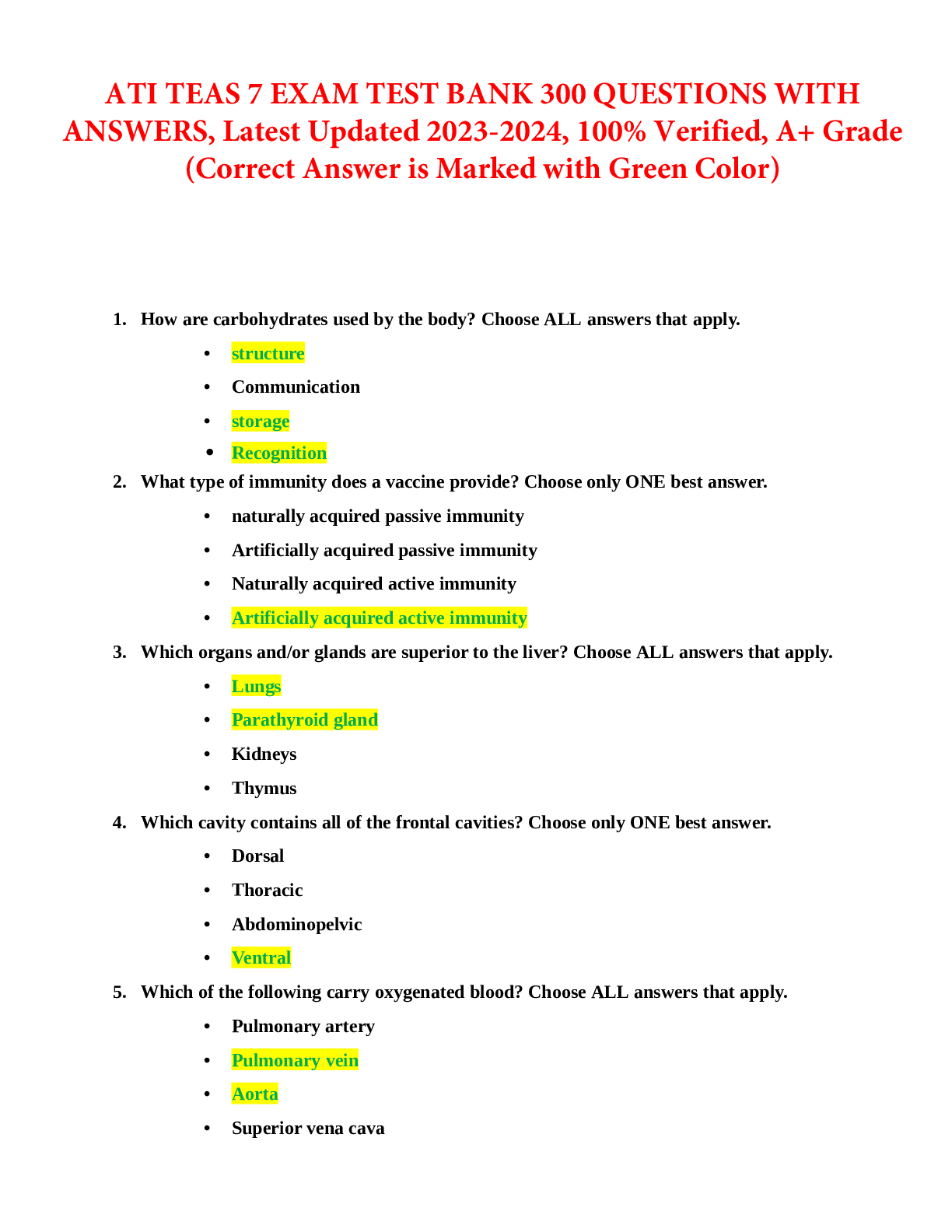
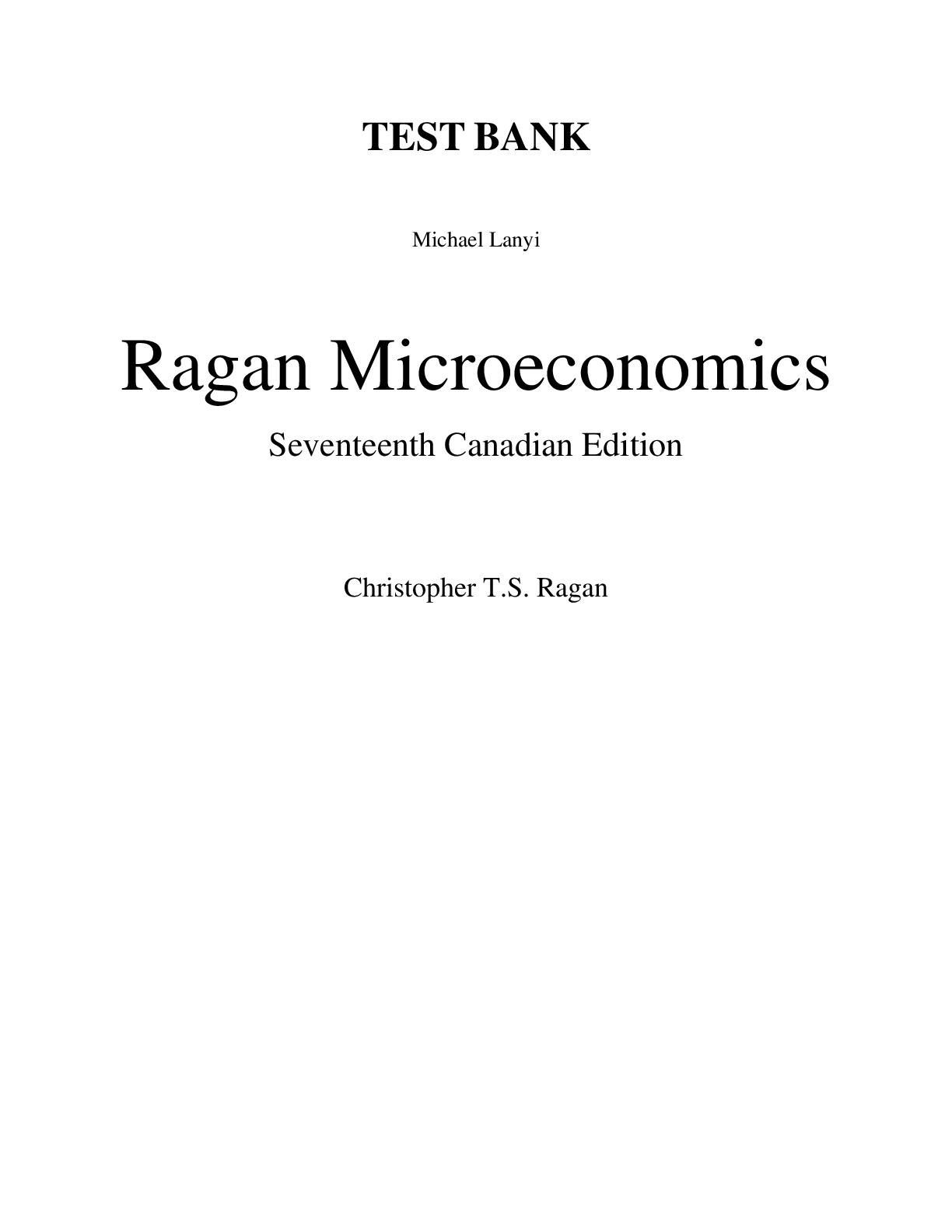
.png)


